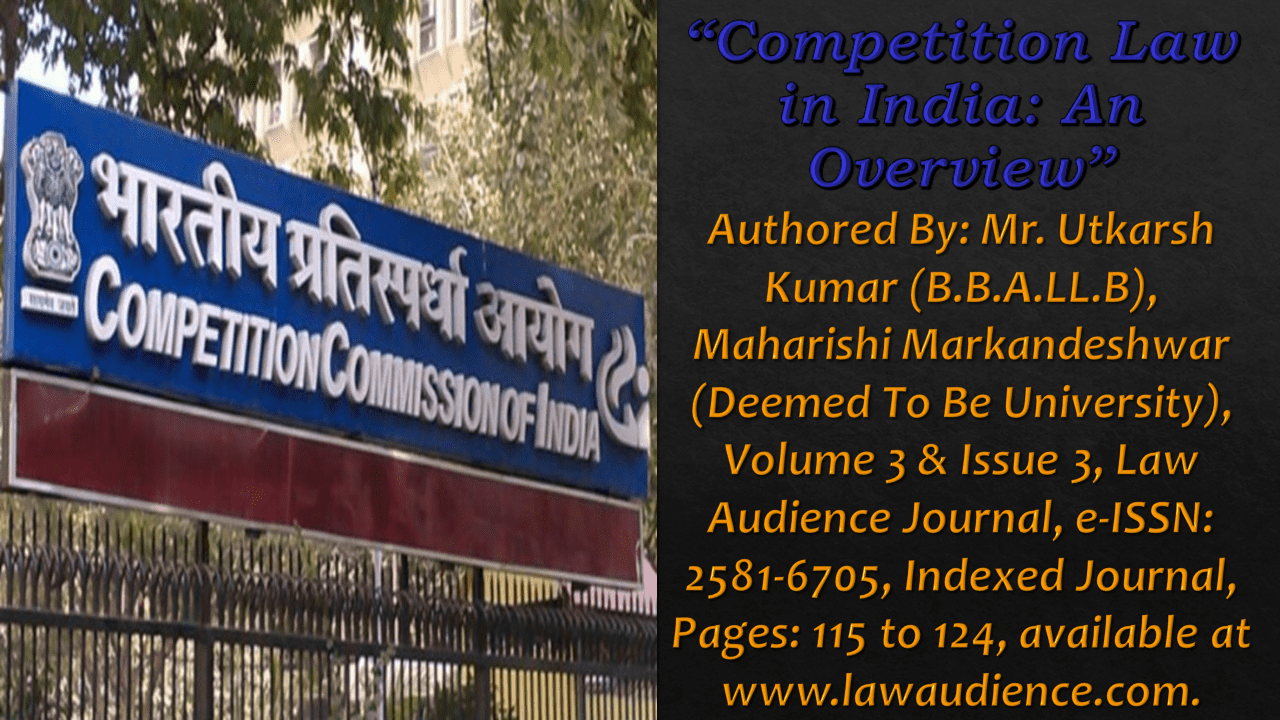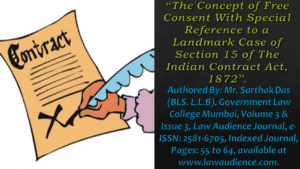Click here to download the full paper (PDF)
Authored By: Mr. Utkarsh Kumar (B.B.A.LL.B), Maharishi Markandeshwar (Deemed To Be University),
Click here for Copyright Policy.
ABSTRACT:
“In order to curb anti-competitive behaviour and unfair trade practises, many countries have created their own competition laws. The primary goal of competition law is to ban certain market practises that harm enterprises, customers, or both, as well as to limit market behaviour that is unethical. In India, the Competition Act of 2002, was enacted to ensure the long-term viability of market competition while simultaneously considering consumer interests and allowing market participants to freely trade. This rule promotes entrepreneurship and frees the market from the restraints of larger trading organisations’ manipulation[1]. Anti-competitive agreements (vertical or horizontal agreements), misuse of dominant position, and combinations are all addressed under the Act (which include acquisition, merger, amalgamation and joint venture)”.
I. INTRODUCTION:
India has had its own version of competition law for 40 years, which was created by the Monopolies and Restrictive Trade Practices Act 1969. (MRTP Act). This legislation, which was based on the principles of a “command and control” economy, was intended to establish a regulatory regime in the country that would prevent the concentration of economic power in a few hands that would be detrimental to the public interest, and thus prohibit any monopolistic and restrictive trade practises. Following the 1991 economic liberalisation, it became critical to establish a competition law regime that was more responsive to the country’s economic realities and consistent with worldwide trends.
As a result, in 2002, the Indian Parliament passed the Competition Act 2002 (Competition Act) to regulate corporate activities in India in order to avoid behaviours that have an appreciable adverse effect on competition (AAEC) in India[2]. The Competition Commission of India (CCI), was founded under the provisions of the Competition Act, and is entirely responsible for the enforcement and administration of the Act. The enforcement body, which is made up of two to six members and a chairperson selected by the Indian government, can launch an investigation on its own initiative or based on information it has. The office of the Director-General (DG) is the CCI’s investigation wing, and it’s in charge of looking into anti-competitive actions. Its powers include calling, inspection, and demanding the attendance of anyone, among other things. One of the more intriguing aspects of the Competition Act is the philosophy on which it is founded, known as the ‘effects doctrine[3].
The Competition Act attempts to regulate three types of activity: anti-competitive agreements, misuse of a dominant position, and combinations (i.e., mergers, acquisitions and amalgamations). When the Indian government notified the parts of the Competition Act dealing to anti-competitive agreements and abuse of dominant position, the Competition Act, as amended by the Competition (Amendment) Act 2007, went into effect on May 20, 2009. After a three-year delay, the Competition Act’s merger control mechanisms were ultimately enacted in June 2011.
Any agreement that is likely to result in an AAEC in the market is considered void under the Competition Act. An agreement can be horizontal (i.e., between businesses, individuals, or associations engaged in the same or similar trade of products or provision of services) or vertical (i.e., between businesses, individuals, or associations engaged in the same or similar trade of goods or provision of services) (i.e., amongst enterprises or persons at different stages or levels of the production chain in different markets)[4].
Bid rigging, often known as collusive bidding, is a type of horizontal agreement that falls under section 3 of the Competition Act. Anti-competitive agreements, both horizontal and vertical, that may have an AAEC in India are covered in Section 3[5]. Bid rigging is frequent among micro, small, and medium-sized firms (MSMEs), as MSMEs sometimes feel compelled to compensate for or catch up with the market’s leading players. Given MSMEs’ capacity to contribute to fair economic growth, it is vital that their interests are protected, and that they are informed about the legal and institutional procedures available to do so[6]. The Competition Act also established a new enforcement body, the Competition Commission of India (CCI), which is solely responsible for the Competition Act’s implementation and administration. The CCI is made up of a chairperson and at least two and no more than six other members selected by the Indian government.
The CCI currently has five members, including Ashok Kumar Gupta, the chairman. The CCI has the jurisdiction to launch an investigation into an anti-competitive agreement or abuse of dominant position on its own, based on facts or knowledge in its possession, or upon receipt of information or a referral from the government or a statutory authority. Anti-competitive agreements and misuse of dominant position can be reported by anybody, including consumers and their associations. In the case of mergers and acquisitions, the CCI may launch an investigation on its own or based on information from the enterprises proposing the merger.
The CCI and its investigative arm, the Office of the Director General (DG), have broad investigative powers against anti-competitive conduct, including the ability to summon and compel the attendance of any person, question them under oath, receive evidence by affidavit, and other similar procedures.
The Government of India established an Expert Committee in June 2011 to evaluate and recommend amendments to the Act based on lessons learnt from its operation and the work of the CCI. The changes, which were authorised by the Cabinet in October, are intended to fine-tune the regulations to reflect the current circumstances and lessons learnt through time. As a result, on December 7, 2012, the Central Government introduced the Competition (Amendment) Bill, 2012 (the “Bill”) in the Lok Sabha. Before being handed to the President for his signature, a measure must normally pass both Houses (Lok Sabha and Rajya Sabha).
II. MRTP ACT, 1969:
For nearly 200 years, the British East India Company ruled India. They used India’s resources for their personal gain, destroying the indigenous industries that existed in India at that time – handicrafts, for example. There was no competitive regime in India before to independence. There were only government policies and resolutions aimed at a just and equal distribution of resources[7]. The World Wars, on the other hand, resulted in the beginning of the Indian economy’s industrialisation. India was the principal source of guns and ammunition for the British army, although not actively engaging in the conflicts.
As a result, large commercial conglomerates such as Tata, Birla, and others were formed. This was first seen as a good sign for India’s rising economy[8]. Following independence, India implemented a centralised planning framework — five-year plans – that outlined how the country’s resources would be employed over the next five years. The fundamental goal of the first five-year plans was to achieve Industrial and Economic Development.
The Industrial Policy Resolution of 1956 categorised all of the country’s industries into three categories: Schedule A, Schedule B, and Schedule C businesses. The pattern of industrial development was largely determined by the government. Most of the laws and regulations enacted at the period were based on the Command-and-Control Principle[9].
The government interjected heavily into the activities of private enterprises and businesses. The goal was to enhance the county’s public sector, which could only contribute to economic progress. Many refer to this period as the “License Raj,” in which private industries were needed to obtain permission licences from the government in order to operate, and high tariffs and quotas were imposed on goods imports[10]. The government used to assist the Big Business Houses since they were important contributors to the economy’s growth. Obtaining licences and approvals became a piece of cake for them. It quickly resulted in the concentration of economic power in the hands of a select few.
These monopolistic industrialists began engaging in anti-competitive behaviour that harmed the overall public interest. It also went against the fundamental ideas that guided the creation of the Indian Constitution, the country’s bible[11]. The Monopolies and Restrictive Trade Practices Act, 1969 [MRTP, Act] was enacted as a result of this scenario. The MRTP Act was enacted to ensure that the economic system does not result in the concentration of economic power in the hands of a few individuals.
II.I PRIMARY AIM OF MRTP ACT, 1969:
On June 1, 1970, the MRTP Act became law. The law was enacted with the sole purpose of –
“Achieving the highest possible productivity with the least amount of public harm”[12].
II.II SCOPE OF MRTP ACT, 1969:
To really comprehend the scope of its applicability, it is necessary to first understand the fundamental aspects that regulate the MRTP Act, 1969. The concepts addressed by the Act are listed below;
- Control and Command Approach:
Before any business restructuring or takeover, enterprises with assets over Rs. 20 crores must obtain Central Government clearance, according to the Act. The criterion for determining the leading ventures was also established. Enterprises with assets of greater than Rs. 1 crore were considered dominant by default[13].
- Monopolistic Trade Practices:
MTPs, as defined in Chapter IV of the MRTP Act, are activities carried out by Big Business Houses that obstruct or abolish healthy market competition by abusing their market position. Such methods are anti-welfare for consumers.
- Restrictive Trade Practices:
RTPs are market activity that obstruct the flow of capital or profits. Some businesses try to limit or control the supply of commodities or products on the market by limiting production or limiting delivery. The MRTPA discourages and prohibits businesses from engaging in RTPs[14].
- Unfair Trade Practices:
UTP is defined as a company’s false, deceptive, misleading, or distorted depiction of facts about its goods and services. Unfair Trade Practices are prohibited under Section 36-A of the MRTPA (UTPs). The ground breaking 1984 Amendment to the MRTPA included this clause[15].
The MRTP Act also called for the creation of the MRTP Commission, which would serve as a regulatory body in charge of dealing with MRTP Act violations. The MRTP Act, as India’s first competition law legislation, appeared to be a great statute to detect defaulters at the time of its passage. The wave of globalisation that swept over the country, however, altered the entire scenario[16]. In order to keep up with the changing economic situation, changes to the existing MRTP Act were required. Many flaws in the law emerged.
II.III LOOPHOLES IN MRTP ACT, 1969:
- Excessive Government Control:
Small and large firms were both susceptible to heavy government supervision under the MRTP Act. Before undergoing any type of corporate reorganisation or takeover, businesses were required to obtain government clearance. Due to the complexity of the procedures, many businesses struggled to survive, influencing the final consumers.
- Obsolescence:
The MRTP Act was quickly rendered outdated due to the dynamic shift of the Indian trade market towards an open and more globalised economy, particularly following the New Economic Policy Reforms.
- Vague And Ambiguous Law:
The phrase “restrictive trade practises” was defined in Section 2(o) of the MRTP Act to include any behaviour that prohibited, distorted, or restricted competition. There was no particular provision in the Act that outlined the many types of anti-competitive acts that would be considered offences. Cartels, bid rigging, abuse of dominance, collusion, price-fixing, predatory pricing, and other anti-competitive actions were not defined[17]. As a result, Section 2(o) encompassed all forms of conceivable offences, resulting in a wide range of interpretations by various courts, with the basic spirit of the statute lost.
- Policy of Voluntarily Disclosure:
Because there was no agency that could maintain a constant eye on market control and company structuring, the MRTP Act machinery was heavily reliant on voluntary disclosures provided by businesses. This provided firms with a significant amount of leeway, resulting in late or non-registration of any changes to the company structure. This served as a way to keep the corporation out of the Act’s reach[18].
- Inefficiency of MRTP Commission:
The MRTP Commission was established to regulate the country’s anti-competitive practises. Despite the fact that the MRTP Commission had both administrative and judicial duties, the members of the Commission were nominated by the government, casting doubt on its independence.
- No Penalties for Offences:
Section 12 of the MRTP Act dealt with the MRTP Commission’s authority and the types of orders it can issue in the event of anti-competitive behaviour. We can infer from a simple reading of the clause that the Commission lacked the authority to inflict punitive penalties or fines on the defaulters. Its only options are to issue ‘stop and desist’ orders or levy small fines. Despite the fact that jail terms were provided for, they were rarely used[19].
As a result, it was evident that the MRTP Act of 1969 failed to achieve the goal for which it was enacted in the first place. The Commission lacked many powers and was mostly involved in consumer cases. Furthermore, far than strengthening the government’s stance on monopolistic and anti-competitive behaviours, the various revisions undermined and liberalised it.
III. RAGHAVAN COMMITTEE REPORT, 1999[20]:
The Raghavan Committee was formed to recommend reforms to India’s competition policy. It made the following suggestions:
- MRTPC is being wound up and CCI is being set up.
- Bring government monopolies and foreign corporations inside the competition law umbrella.
- New mergers, predatory pricing, and abuse of dominance limits and rules are being established.
- All pending MRTPC cases will be transferred to CCI.
IV. COMPETITION ACT, 2002:
In his 1999 financial speech, India’s then-Finance Minister unveiled the Competition Law of 2002. The new law closes all of the significant loopholes in the previous MRTP Act. The 2002 Competition Act is particularly concerned with these issues:
- Anticompetitive Agreements;
- Regulation of combination;
- Abuse od dominance;
- Competition Advocacy;
- Extra territorial jurisdiction;
The new Act also established the Competition Commission of India (CCI) as a quasi-judicial agency for registering all complaints and the Competition Appellate Tribunal (COMPAT) to hear appeals against CCI orders[21].
It’s a mechanism for enforcing and implementing competition policy, as well as preventing and punishing anti-competitive business behaviour and needless government intervention in the market. Written and spoken agreements, arrangements, and agreements between firms or individuals are all subject to competition regulations. The goal of the Act is to create the legal structure and processes needed to ensure that competition policies are followed, to deter anti-competitive behaviour, and to punish those who engage in it. The Act protects both free and fair competition and trade freedom.
V. CASE LAWS:
Brahm Dutt vs. Union of India[22],
The constitutionality of the appointments made under the newly established Competition Law of 2002 was contested in this case. It was argued that because CCI had adjudicatory powers as well, the Chairman of CCI should be a former Supreme Court or High Court judge, rather than an expert in any subject, as the Act required. The Supreme Court ruled that choosing an expert as Chairman of the Committee was a standard procedure in many jurisdictions. Furthermore, the Competition Act established an appeals tribunal, COMPAT, which was chaired by a retired judge. In the event that a party is dissatisfied with the CCI’s orders, they can appeal to the appellate tribunal. Thus, the petition was dismissed.
VI. CONCLUSION:
As has been correctly said, any law’s positive impacts can only be realised if it is adequately implemented. It’s the same as not having the law at all if the law isn’t enforced properly. The same may be said for the recently enacted Competition Law, whose jurisprudence is still in its infancy.
However, as a researcher, I’d like to make some ideas of my own – CCI should aim to concentrate more on violations of competition law that affect the vast majority of people. The majority of the cases that this authority has decided so far involve specialty markets that are dominated by the country’s wealthiest 10%. It should also take a strong stance against anti-competitive behaviour by foreign enterprises and the negative consequences for the Indian economy.
As a result, we can infer that in order to boldly tackle the difficulties provided by globalisation in Indian markets, we require a good competition policy as well as an efficient and effective competition law.
Cite this article as:
Mr. Utkarsh Kumar, “Competition Law in India: An Overview”, Vol.3 & Issue 3, Law Audience Journal (e-ISSN: 2581-6705), Pages 115 to 124 (21st January 2022), available at https://www.lawaudience.com/competition-law-in-india-an-overview/.
Footnotes & References:
[1] Karney, Competition law in India, available at https://www.legalserviceindia.com/legal/article-1814-competition-law-in-india.html.
[2] Samir Gandhi, Hemangini Dadwal and Indrajeet Sircar, Antitrust and Competition in India, available at https://www.globalcompliancenews.com/antitrust-and-competition/antitrust-and-competition-in-india/.
[3] Gagan Anand & Shivani Anand, Indian Competition Law: A Comprehensive Analysis of MSMEs and Bid Rigging, available at https://www.ibanet.org/Indian-competition-law-analysis.
[4] Provisions Relating to Bid Rigging, Advocacy Booklet Series 3, Competition Commission of India, 4, 4–10.
[5] Section 3, The Competition Act 2002, No 12, Acts of Parliament 2003 (India).
[6] Ashita Allamraju, Palakh Jain, Chavi Asrani, MSMEs and Competition Law in India: Victims or Perpetrators, Review of Socio-Economic Perspectives, Vol 5 Issue: 1 April 2020, at 25.
[7] Amit Kapoor, Competition Regulation-History, Insights and Issues for The Way Forward, 2009, Manupatra (2009).
[8] Aditya Bhattacharjea, India’s New Antitrust Regime: The First Two Years of Enforcement, 57 Antitrust Bull. 449 (2012).
[9] Dorothy Shapiro, A Competition Act by India, For India: The First Three Years of Enforcement Under the New Competition Act, 5 Indian J. Int’l Econ. L. 59 (2012).
[10] S. Chakravarthy, India’s New Competition Act 2002 – A Work Still in Progress, 5 Bus. L. Int’l 240 (2004).
[11] UK Essays, MRTP Act: Rise Fall and Need for Change: Eco Legal Analysis, November 2013.
[12] Preamble, Object and Reasons, Monopolies and Restrictive Trade Practices Act, 1970.
[13] Mohammad Asad Mahmood, Critical Analysis of Competition Law in India, Latestlaws.com.
[14] R. Shyam Khemani, India’s Competition Policy Reforms, 30 Int’l Bus. Law. 7 (2002).
[15] Shiju Varghese Mazhuvanchery, The Indian Competition Act: A Historical and Developmental Perspective, 3 Law & Dev. Rev. 241 (2010).
[16] CUTS International, National Law University, Jodhpur & Study of Cartel Case Laws in Select Jurisdictions – Learnings for the Competition Commission of India, COMPETITION COMMISSION of INDIA, Apr. 25, 2008.
[17] Haridas Exports v. All India Foat Glass Manufacturers Association (2002) 6 SCC 600.
[18] Vijay Kumar Singh, Competition Law and Policy in India: The Journey in A Decade, 4 NUJS L. Rev. 523 (2011).
[19] Amit Kapoor, Competition Regulation-History, Insights and Issues for The Way Forward, 2009 Manupatra (2009).
[20] Report of ‘The High-Level Committee on Competition Policy and Law’ – Dept. of Company Affairs, Govt. of India, New Delhi, 2000.
[21] Preamble, Statement of Objects and Reasons, Competition Act, 2002.
[22] (2005) 2 SCC 431; MANU/SC/0054/2005.



